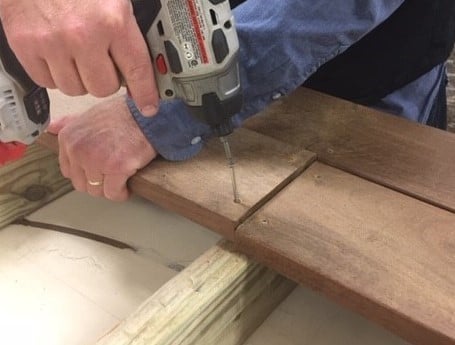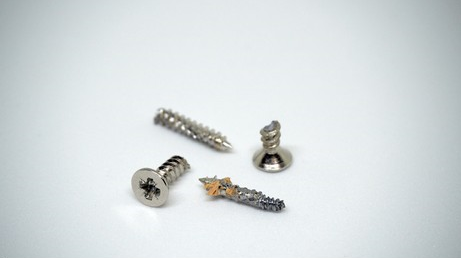Stainless Decking Screws Snapping?
Why Are My Stainless Decking Screws Snapping?
We're going to take a look in this article at stainless decking screws and why you may be snapping some.
This is a super common question that we get asked all the time, "will your decking screws snap?" "i've bought another brand and alot are snapping, will yours not snap?".
The answer isn't that simple unfortunately, we'd love to say "our screws definitely won't snap" but that may not necessarily be true. Although of course we only manufacture the highest quality decking screws, this doesn't guarantee that you won't snap some.
Theres a few important factors to consider when using stainless decking screws and a few reasons as to why you may be snapping some of them, heres the main ones:
- Stainless is soft.
- Thread profile of the screws
- Head profile of the screws
- Impact Driver - Timber Types
Lets take a look at each of these points a bit closer
Stainless Screws Are Soft
There is a super common misconception about stainless that alot of people fall into. Price does not determine strength.
Just because stainless is more expensive than standard carbon steel screws does not make it stronger.
In fact, quite the opposite, stainless screws are torsionally weaker than carbon steel and are actually quite soft.
The funny thing is, the higher grade stainless you go 304 to 316 for instance, the softer the screws become and the more the price goes up!

Without getting too bogged down in the differences between the steels (we'll have a blog post later on the specific types of steel.
The main difference when it comes to screws is you cannot heat treat stainless steel, whereas you can heat treat carbon steel.
Also the more carbon in the steel the stronger it is (generally speaking)
This means that in every stainless screw your installing has not been hardended, has little to no carbon and has not been heat treated, where every galvanised or zinc plated screw you put in has.
This is where the big difference comes from.
This is why stainless screws are torsionally weak and this is also why you can snap some stainless screws when screwing into hard hardwoods.
Now there is differing grades of stainless 304/316 etc and then within those there a few different grades which is where some stainless deck screws can snap alot and others not so much.
Thread Profile
This is one of the most important factors when choosing decking screws and is often the most overlooked
Now that we've determined that stainless is quite soft and torsionally weak, the next logical step is to start being concerned with the amount of torsion going through the screw when installing, this will directly effect your snap rate.

As you can see on the image above there is alot more to a screw thread than meets the eye
Thread angle, pitch diameter and minor/major diameter are absolutely key in reducing torsion when installing a screw, particularly in hardwood joists and boards.
Cheap or none specialist (hardware chains) oriented fastener manufacturers will manufacture decking screws with incorrect thread angles, incorrect or non-optimal major diameters in order to reduce costs or sometimes to be honest, they just don't know what they're specifiying when having screws manufactured.
We've seen countless manufacturers of screws incorrectly specify thread pitches and therefore produce very poor screws.
Thread profile makes a huge difference on the torsion when installing the screw.
This is why sometimes when installing stainless decking screws, you can have a really good experience with very minimal snapping with one brand, then a poor experience with another.
Generally it's not the specified stainless (although it can be), it's more so the thread profile.
Head Profile
Again, back onto torsion.
Another key element in reducing torsion is the profile of the head.

When manufacturing decking screws the head profile is a massive part of the puzzle that needs to be correctly solved.
Things to consider are:
- Head diameter
- Height of the countersink
- Width of driver recess
- Depth of driver recess
- Type and diameter of underhead ribs
A common mistake we see from screw manufacturers is that they cut the driver recess too deep into the screw. This creates a large weakness where the head connect to the shank and causes the heads to frequently spin off.
An issue im sure many of you have had.
The countersink angle is also key, imagine trying to push a super wide countersink into a hardwood board, the torsion would be huge. Whereas a shallow, thin angle can cut into the board easily without much hassle.
We see these common head mistakes made all the time. It's super prevalent in lower tier manufactuers decking screws and causes a huge amount of issues for clients.
Impact Driver and Timber Types
This is usually the biggest cause of issues and unfortunately it isn't one that we can always get around.
We can product perfect screws everytime, with perfectly specified heads that reduce torsion as much as possible, perfectly manufactured threads that again reduce torsion as much as possible and sometimes it's still not enough.
If your driving the screws directly into very tough hard wood boards, with a powerful impact driver and giving it full beans. You will snap stainless screws.
At the end of the day, stainless is soft, impact drivers are powerful and some hardwoods are hard. This isn't something we can get around with well thought out manufacturing.
If you have a super hard board, your just going to have to pre-drill it. If you have a super hard joist, you're just going to have to pre-drill the entire length of the screw.
Here in Australia and in other countries around the world we have some extremely hard hardwoods, some aged hardwoods are nearly as tough as steel. You're just not going to get a stainless screw that will directly screw into it with any sort of consistency. No matter how well it's made and no matter how much you pay.
If you're snapping screws the first thing you should do is:
- Start pre-drilling (if problem persists, increase diameter of pre-drill and make sure you're drilling the entire length of the screw)
- Turn the speed/torsion down on your drill
- Make sure your cutting the correct size countersink

You can find our full range of various types of decking screws here: Screws
Thanks for reading our latest blog entry
Best Regards,
The Scrooz Fasteners Team

